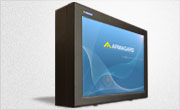Plasma and LCD – Essential Differences for Digital Signage
Posted by: Richard Williams | Posted on: | 0 Comments
Since flat screen television emerged in the 1990s and started to replace the bulky cathode ray tubes, they came in two distinct types: the LCD (liquid crystal display) and the plasma. Both these types of televisions come in modern High Definition, and have pros and cons regarding their use. For normal TV viewing, there is little difference in choosing either type. While traditionally, plasma screen were larger and provided a wider contrast range, with modern advances in LCD technology, this is no longer the case.

For digital signage, the same choice needs to be made, but what are the differences to the two types of television, and the advantages and disadvantages of each type?
Cost
LCD televisions are pretty much the screen of choice for most digital signage applications, as LCDs have one major advantage – cost. Typically, the same size LCD screen will cost less than a similar plasma model; however, there is a downside to using LCDs over plasma.
Longevity
One disadvantage is the longevity of the screen. Because LCD TVs do not generate their own image brightness – this is provided by a backlight system, which illuminates the screen often with fluorescent tubing behind the screen face, the result is a gradual fading of brightness.
A typical LCD display lasts for only about five years of continuous use. Commercial screens often last a little longer as they are designed for continuous 24-hour use, but most LCD screens will still start to fade after five to six years. Modern backlight systems such as LEDs are helping to change this situation, providing a more efficient method of providing screen brightness, which is less susceptible to screen fade.
Image Burn
A problem that affects plasma screens is image burn. This is caused by stationary images on the screen, causing hotspots on the plasma screen face. This is less of problem with modern plasma screens but can still occur, so for this reason, any digital signage that replays continuous, repetitive imagery, such as non-moving text, is best displayed on an LCD screen.
Brightness
Because plasma screens generate their own brightness without the need of a backlight, plasmas tend to have a wider colour and brightness range. This makes them ideal for outdoor digital signage where high brightness is necessary to cope with sunlight levels. However, many high brightness LCDs are now available on the market, which eliminates this advantage.
Size
Traditionally, manufacturers of plasma screen were able to produce much larger screens than the manufacturers of LCDs. However, in recent years, larger and larger LCD screens have emerged on to the market with some giant-sized 100” plus LCDs now produced by many manufacturers. And most LCD manufacturers produce screens that go up to 70” which is large enough for most digital signage applications.
Because of the lower cost and advances in size and screen brightness, LCD televisions are now the preferred choice for digital signage, but many people still employ plasmas, but knowing the limitations and advantages is important when you are planning to use a screen for digital signage, regardless of whether your intention is to use plasma or LCD.
Post shortlink:
Popular Products
LCD Enclosure
Need armor for your LCD/LED screen(s)? Outdoors or inside the versatile LCD enclosure protects against thieves, vandals & the weather. Installation idea: NFL stadiums.
Outdoor Digital Signage
Exclusive 46” outdoor screen protection. Dubbed the ‘Totem’, due to its distinct design, it repels damage threats, but attracts audiences. Installation idea: Drive-thru restaurants.
Portrait Flat Panel Enclosure
Safeguard your eye-level advertising display screen(s), indoors or outdoors. Completely customizable, add exciting features like touch screen technology. Installation idea: Restaurant frontages.
Indoor Digital Signage
Popular purchase for retail outlets! Great for ‘point of sale’ persuasion, boost your brand with static & motion advertising from a single unit! Installation idea: Mall of America.




